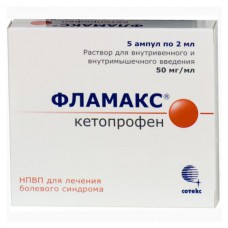Expiration date: 03/2026
The composition and form of issue:
Solution for intravenous and intramuscular administration of 1 amp. (2 ml)
active substance:
Ketoprofen 100 mg
excipients: propylene glycol ethanol (ethyl alcohol 95% in terms of 100% substance) benzyl alcohol sodium hydroxide water for injection
in ampoules of glass lighting 2 ml, in a contour acheikova package 5 PCs. in cardboard pack 1 or 2 packs.
Description of dosage form:
Transparent colorless or slightly brownish solution.
Characteristic:
NSAIDs, a derivative of propionic acid.
Pharmacokinetics:
Distribution. Up to 99% of absorbed Ketoprofen binds to plasma proteins, mainly albumin. Smax in plasma is achieved quickly due to low Vd (0, 1-0, 2 l/kg). CSS Ketoprofen is achieved 24 hours after the beginning of its regular reception. Ketoprofen well penetrates into synovial fluid and connective tissue. Significant levels of concentrations in synovial fluid are achieved in 15 minutes after a single I/m administration of 100 mg Ketoprofen. Although the concentration of Ketoprofen in synovial fluid is slightly lower than in plasma, they are more stable (stored up to 30 h), resulting in a long time decreases pain and stiffness of the joints.
Metabolism, excretion. Ketoprofen is mainly metabolized in the liver, where it is subjected to glucuronidation to the formation of esters with glucuronic acid, derived mainly by the kidneys. The excretion with the feces is less than 1%. T1/2 of Ketoprofen ranges from 1, 6 to 1, 9 p.m. Not koumouliruet.
Description of the pharmacological action:
It has analgesic, anti-inflammatory and antipyretic effect, suppresses platelet aggregation. Acting on the cyclooxygenase and lipoxygenase link of arachidonic acid metabolism, Ketoprofen inhibits the synthesis of PG and Tx. Analgesic effect is due to both Central and peripheral mechanisms. It has antibacterial activity, stabilizes lysosomal membranes.
Indications:
NSAIDs for the treatment of pain.
Designed for symptomatic therapy, reduce pain and inflammation at the time of use, the progression of the disease does not affect.
inflammatory and degenerative diseases of the musculoskeletal system:
- rheumatoid arthritis
- is seronegative arthritis: ankylosing spondylitis (Bechterew's disease), psoriatic arthritis, reactive arthritis (Reiter's syndrome)
- gout, pseudogout
- osteoarthrosis
pain syndrome:
- tendinitis, bursitis, myalgia, neuralgia, radiculitis
- headache
- post-traumatic and postoperative pain syndrome
- pain syndrome in cancer
- algodismenorrhea.
Contraindications:
- hypersensitivity to Ketoprofen or other components of the drug, as well as salicylates or other NSAIDs
- bronchial asthma, rhinitis or urticaria in history caused by taking acetylsalicylic acid or other NSAIDs
- peptic ulcer of the stomach or duodenum in the stage of exacerbation
- ulcerative colitis, Crohn's disease
- hemophilia and other blood clotting disorders
- children's age (up to 15 years)
- severe hepatic insufficiency
- expressed kidney failure (Cl creatinine <30 ml/min.)
- decompensated heart failure
- postoperative period after coronary artery bypass grafting
- gastrointestinal, cerebrovascular and other bleeding (or suspected bleeding))
- III trimester of pregnancy, lactation.
Caution: bronchial asthma in anamnesis, data on the development of ulcerative lesions of the gastrointestinal tract in history, with confirmed Helicobacter pylori infection, symptomatic cardiovascular, cerebrovascular disease and peripheral artery disease, congestive heart failure, dyslipidemia/hyperlipidemia, hyperbilirubinemia, diabetes, renal failure, hepatic failure, arterial hypertension, blood disorders, dehydration, Smoking, deficiency of glucose-6-phosphate dehydrogenase, creatinine Cl <60 ml/min, advanced age, prolonged use of NSAIDs, frequent use of alcohol, alcoholic cirrhosis of the liver, severe somatic diseases, concomitant therapy with anticoagulants (eg warfarin), antiagregants (eg acetylsalicylic acid, clopidogrel), oral GCS (eg prednisolone), cioss (eg tsitalopram, fluoxetine, paroxetine, sertraline).
Application during pregnancy and breast-feeding:
In pregnancy (I, II trimester) is possible only if the intended benefit to the mother exceeds the potential risk to the fetus.
Side effect:
Digestive system: abdominal pain, dyspepsia, stomatitis, impaired liver function rarely — change taste.
Nervous system: insomnia, excitement, nervousness, depression, asthenia rarely — confusion or loss of consciousness, memory impairment, migraine, peripheral neuropathy.
Senses: ringing in the ears, blurred vision, rarely — conjunctivitis, dryness of the mucous membrane of the eye, eye pain, conjunctival hyperemia, decreased hearing, dizziness.
SSS: increased blood pressure, rarely — tachycardia.
Hematopoietic organs and blood: rarely — agranulocytosis, anemia, hemolytic anemia, thrombocytopenia, leukopenia.
Urinary system: edema syndrome rarely-cystitis, urethritis, impaired renal function, interstitial nephritis, nephrotic syndrome rarely — hematuria.
Allergic reactions: skin rash (including erythematous, urticaria), itching of skin, rhinitis, angioedema rare — bronchospasm, exfoliative dermatitis, anaphylactic shock.
Other: increased sweating rarely — hemoptysis, epistaxis, myalgia, muscle twitching, shortness of breath, thirst, photosensitivity long-term use in high doses, vaginal bleeding.
Drug interaction:
With the simultaneous appointment of Ketoprofen and loop diuretics nephrotoxic effect of both drugs increases. Ketoprofen reduces the effectiveness of uricosuric drugs, increases the effect of anticoagulants, antiplatelets, fibrinolytics, ethanol, side effects of GCS and mineralocorticosteroids, estrogens reduces the effectiveness of antihypertensive drugs and diuretics.
Joint reception with other NSAIDs, GKS, ethanol, corticotropin may lead to ulceration and development of gastrointestinal bleeding, the increased risk of impaired renal function.
Co-administration with oral anticoagulants, heparin with thrombolytic drugs, antiplatelet agents, cefoperazone, cefamandole and cefotetan increases the risk of bleeding.
Increases hypoglycemic effect of insulin and oral hypoglycemic drugs (requires the recalculation of doses).
Inductors of microsomal oxidation in the liver (phenytoin, ethanol, barbiturates, rifampicin, phenylbutazone, tricyclic antidepressants) increase the production of hydroxylated active metabolites.
Joint administration with sodium valproate leads to a decrease in platelet aggregation.
Increases concentration in plasma of verapamil and nifedipine, drugs lithium, methotrexate.
Antacids and cholestyramine reduce the absorption.
Increases hematotoxicity of myelotoxic drugs.
To avoid the formation of sediment should not be mixed in one bottle of Ketoprofen and tramadol.
Method of application and doses:
In/in, in/m.
In / flushed the introduction of: on 100 mg (1 amp.) 1-2 times a day.
On / in the infusion of the drug should be carried out only in hospital.
Short-term in / in infusion: 100-200 mg (1-2 amp.) the drug, diluted in 100 ml of 0, 9% sodium chloride solution, is administered for 0, 5-1 no. possible re-administration after 8 no.
Prolonged on / in infusion: 100-200 mg (1-2 amp.) the drug diluted in 500 ml infusion solution (0, 9% sodium chloride solution, lactate-containing ringer solution, 5% dextrose solution) is administered for 8 hours.
Possible re-introduction in 8 hours.
Ketoprofen can be combined with Central action analgesics it can be mixed with morphine in one bottle, can not be mixed in one bottle with tramadol due to precipitation. Parenteral administration of Ketoprofen can be combined with the use of oral forms (tablets, capsules) or rectal suppositories.
The maximum dose of 200 mg/day.
You should use the minimum effective dose of the minimum possible short course.
Overdose:
Cases of overdose not described. There may be dizziness, vomiting, headache, shortness of breath, abdominal pain, bleeding, impaired liver and kidney function.
Treatment: symptomatic.
Special instruction:
With the simultaneous use of Ketoprofen and warfarin or lithium salts, patients should be under strict medical supervision. Caution should be exercised when prescribing the drug to patients with ulcerative diseases of the gastrointestinal tract in history, renal or hepatic insufficiency, as well as receiving coumarin anticoagulants. Like other drugs in this group, can mask the symptoms of infectious diseases.
During treatment, it is necessary to control the picture of peripheral blood and the functional state of the liver and kidneys.
If it is necessary to determine 17-ketosteroids, the drug should be canceled 48 hours before the study.
In violation of liver function, kidney dose reduction and careful monitoring.
During the period of treatment must be careful when driving and occupation of other potentially hazardous activities, require high concentration and psychomotor speed reactions.
Flamax
(Ketoprofen)
injectable
- Brand: Sotex



